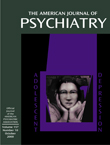Adult Outcomes of Child- and Adolescent-Onset Schizophrenia: Diagnostic Stability and Predictive Validity
Abstract
OBJECTIVE: The goal of the study was to establish the predictive validity of a diagnosis of schizophrenia in childhood and early adolescence by examining diagnostic continuity into adult life and comparing social and symptomatic outcomes of child- and adolescent-onset schizophrenia with those of nonschizophrenic psychoses. METHOD: A total of 110 consecutive patients with first-episode child- or adolescent-onset psychosis (mean age at onset=14.2 years) presenting to the Maudsley Hospital in London between 1973 and 1991 were followed up an average of 11.5 years after first contact. Ninety-three (84.5%) of 110 patients were successfully followed-up, 51 with a first-episode diagnosis of DSM-III-R schizophrenia and 42 with nonschizophrenic psychoses. Consensus best-estimate DSM-III-R diagnoses were made at follow-up, and course and outcome were assessed blind to first-episode diagnosis. RESULTS: Diagnostic stability was high for child- and adolescent-onset DSM-III-R schizophrenia (positive predictive value=80%) and affective psychoses (positive predictive value=83%) but much lower for schizoaffective and atypical psychoses. Compared with other psychoses, child- or adolescent-onset schizophrenia was associated with significantly worse symptomatic and social outcomes, which were characterized by a chronic illness course and severe impairments in social relationships and independent living. CONCLUSIONS: The diagnosis of DSM-III-R schizophrenia in childhood and adolescence has good predictive validity. The high level of diagnostic stability suggests etiological continuity with adult schizophrenia, with onset in childhood and adolescence associated with a particularly malignant course and outcome.



